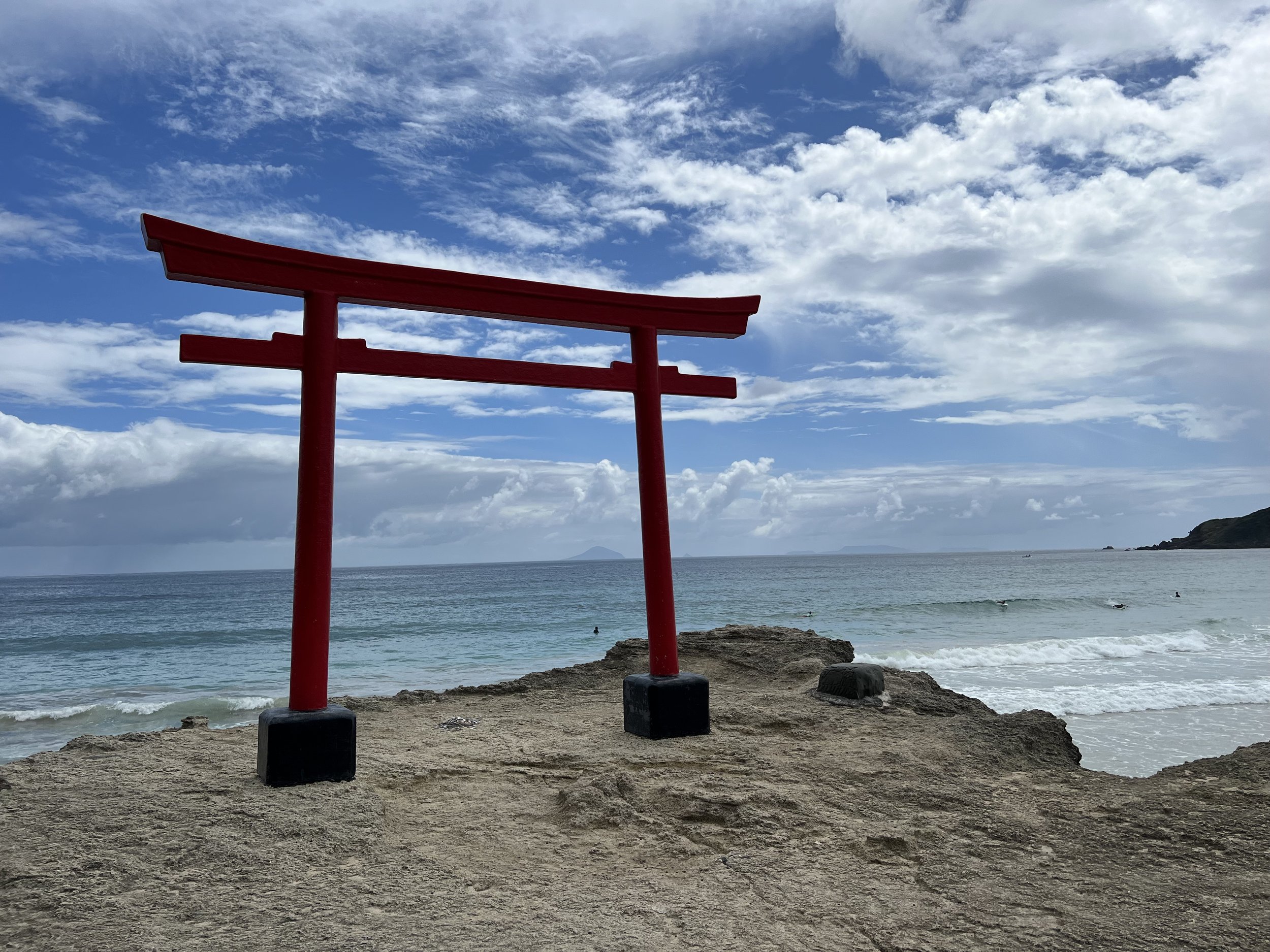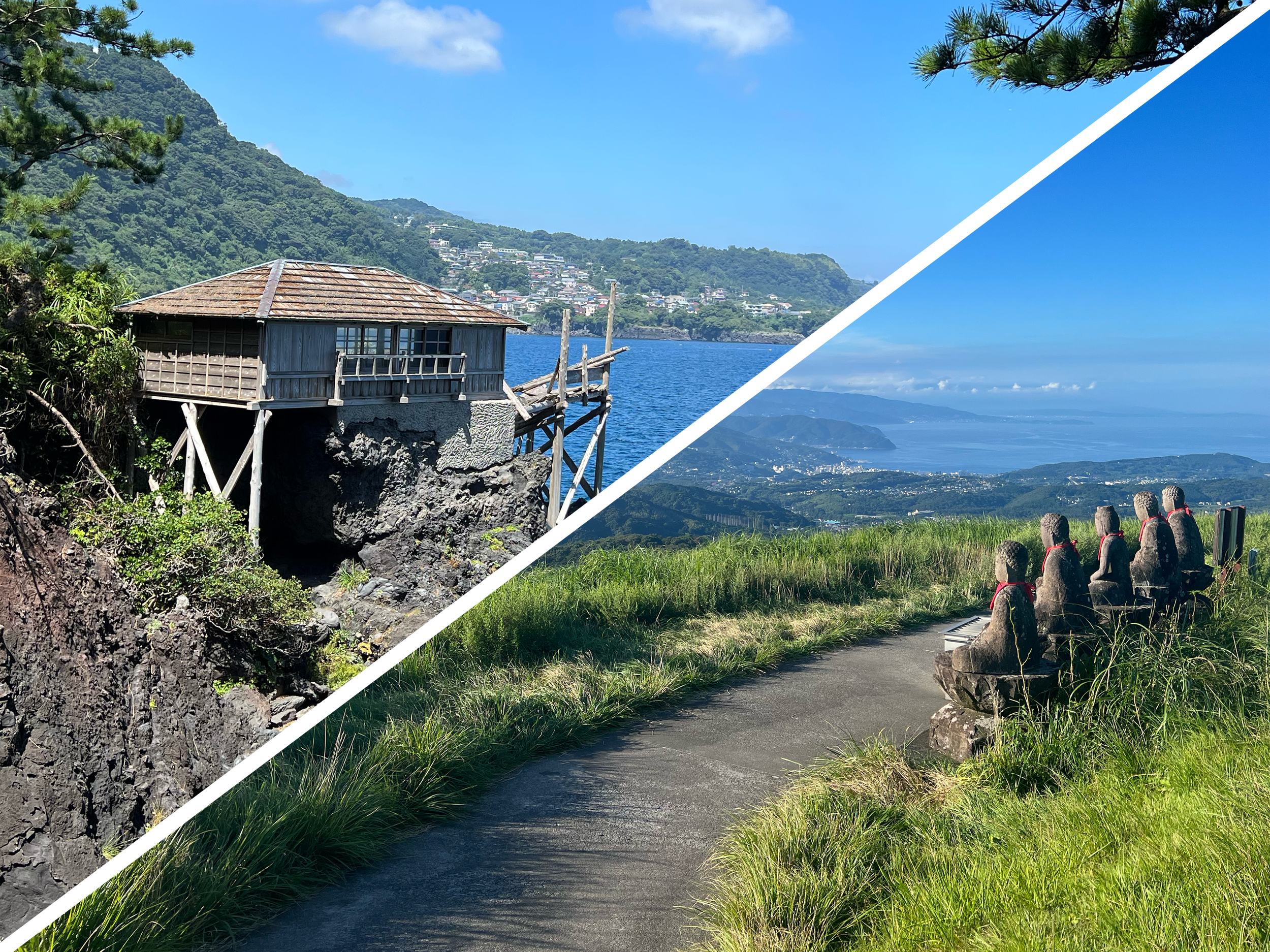Kawazu Seven Falls: A Nature Lover's Hidden Gem on the Izu Peninsula
After writing about the town of Ito, let me introduce you to Kawazu (河津町), another hidden gem on the Izu Peninsula, in Shizuoka Prefecture, Japan.
As a nature lover who spent a week discovering the lesser-known beauty of the Izu Peninsula, I was intrigued and eager to see the Kawazu Seven Falls, also known as Kawazu Nanadaru (河津七滝), a group of seven waterfalls located in the mountains above the coastal town of Kawazu.
You can read about my experience in this article, as well as some recommendations if you want to visit this wonderful natural site.
A Half-Day Itinerary to Discover the Kawazu Seven Falls
Having travelled by local train from Ito, where I’d been staying for a few days, I arrived at Kawazu station just in time to catch a bus outside the station that would take me to the start of the Kawazu Seven Falls walking trail.
The bus journey, which takes around 30 minutes and costs ¥730, takes you through the Japanese countryside and into the mountains. An easy way to know you’re almost there is to spot the Kawazu-Nanadaru Loop Bridge (河津七滝ループ橋), an impressive double spiral bridge (if you look on Google Maps, you may be surprised to see a large circle out of nowhere, well it's that). Soon after, I got off at the Kawazu Nanadaru Onsen (河津七滝温泉) bus stop, located nearby Odaru, the first and biggest of the Kawazu Seven Falls. But first, lunch!
Sampling Wasabi Delights, Kawazu's culinary speciality
I had a great lunch at Wasabi Garden Kadoya (わさび園 かどや), a local restaurant that has been growing wasabi for 4 generations and specializes in wasabi dishes.
I decided to try the namawasabitsuke zarusoba (生わさび付ざるそば), as I love the refreshing taste of cold buckwheat noodles in summer. It was a fun experience: I was given a small piece of raw wasabi, grown locally in the spring water of the nearby Mount Amagi, which I grated myself until it became a paste to put in my dish.
You may already have tried wasabi paste on sushi or other Japanese dishes (and you may or may not be a big fan of it), but I still recommend that you try this unique experience if you have the occasion. I found the wasabi taste purer and fresher than anything I'd tried before!
The restaurant also sells raw wasabi and wasabi-based products such as miso paste or pickles. I don't think you could make a more original and local souvenir, or omiyage, than this!
Setting Off to Discover the Waterfalls
The Kawazu Seven Falls hike lets you follow the river along a boardwalk to see seven waterfalls of different shapes and sizes, each with its own name: Odaru (大滝), Deaidaru (出合滝), Kanidaru (かに滝), Shokeidaru (初景滝), Hebidaru (蛇滝), Ebidaru (海老滝) and Kamadaru (釜滝). The smallest waterfall, Kanidaru (which means crab waterfall), is around 2 metres high, while the largest, Odaru, reaches 30 metres.
Beyond the waterfalls and clear turquoise water, you can admire the geological wonders that characterise the Izu Peninsula, designated as a UNESCO Global Geopark. Along the trail, you'll be able to admire pillar-like rock shapes known as columnar joints, created when molten lava cooled and contracted. I don't want to spoil the walk for you, so I've only included photos of a few waterfalls.
Deaidaru Falls
Column Rock Formations
The statues representing the main characters in Kawabata Yasunari's short story The Izu Dancer are also a point of interest that make for a great photo with the Shokeidaru Falls in the background.
Shokeidaru Falls
Spotting and Getting Stamps from the 7 Gods of Good Fortune Along the Way
Something that I love about exploring Japan is collecting stamps. These stamps can be found at train stations and many tourist attractions, and make original free souvenirs of the places you’ve explored. It is the case in Kawazu, where you can take part in a "stamp rally”: every time you stop at one of the waterfalls, look for a statue of one of the seven gods of good fortune, and get a stamp. So make sure to bring a piece of paper or a dedicated stamps notebook.
Enjoying Kawazu’s Natural Landscape
When I visited in summer, the forest was lush and the walk in the shade of the trees very pleasant. With many Japanese maples trees along the way, I imagine it must be wonderful to do this walk in autumn, when the leaves change colour.
The path is well maintained, and you will cross at some point a suspension bridge, with stairs concentrated nearer the end of the walk, near the last waterfall, called Kamadaru.
I enjoyed this nature walk so much that I was sorry it wasn't longer. The one-way walk is around 1 km and takes 1 hour at a leisurely pace. After reaching the last waterfall, I enjoyed doing the walk in the opposite direction to make it last longer and admire the views from opposite perspectives as I walked down the riverbed.
Ending the Day with a Well-Deserved Hot Spring Bath
After the walk, what could be better than an open-air hot spring bath next to Odaru, the highest of the seven waterfalls? The Amagiso hotel allows day-trippers to use their open-air hot spring bath and seasonal swimming pool for a fee (¥1,000). As it's a mixed bath, you'll need to wear a swimsuit, so don't forget to bring one (you can also rent one at the reception). You can find more information on the hotel’s website here (in Japanese).
I haven't tried it myself, but I would certainly consider stopping for a bath or spending a night at the Amagiso Hotel to try out their other facilities, such as the indoor onsen baths, if I have the opportunity to return in the future. Note: as of April 2025, the hotel is closed due to renovation, but hot spring bath for day trips remains open.
My Itinerary in a Map
How to Get There
There are several options for getting from central Tokyo to Kawazu station, the easiest being to take the JR Odoriko Limited Express Izukyu-Shimoda line from Tokyo or Shinagawa station, which goes directly to Kawazu station in 2.5 hours.
If you're planning to stay in a coastal town on the Izu Peninsula (Ito or Shimoda, for example), you can take the local Ito Line to Kawazu station.
Then, outside of Kawazu station, you can take one of the hourly buses connecting Kawazu and Shuzenji stations, which stops at both the upper and lower ends of the Kawazu Seven Falls trail, that leads past the waterfalls. If you’d like to follow my itinerary, then stop at Kawazu Nanadaru Onsen bus stop (河津七滝温泉). Some people prefer to walk the trail only one-way down. In that case, you can get off at the next bus stop called Mizutare (水垂) and do the hike in the reserve direction.
Travel Tips to Keep in Mind
1/ There are a few lockers at Kawazu station where you can leave your luggage. I stopped in Kawazu to hike the Kawazu 7 waterfalls on my way from Ito to Shimoda, so it was very convenient to drop my suitcase for the duration of the hike.
2/ Check bus timetables in advance (I find that Google Maps is generally accurate) and double-check the bus schedule every time you arrive at a bus stop. As this is the countryside, buses are infrequent, so better be safe than sorry.
3/ Prepare for your walk. Even if the path is well maintained, it can be slippery. So it's best to wear comfortable shoes or hiking boots. There are toilets near the Kawazu Nanadaru Onsen bus stop, as well as a number of restaurants and cafés where you can buy snacks and drinks, if needed.
Where to Stay in Kawazu
I only stoped off in Kawazu before heading to Shimoda, my next destination, but a friend of mine decided to stay overnight after doing the Kawazu Seven Waterfalls Hike and warmly recommended Kokoronodoka. This old house converted into a ryokan is located one station from Kawazu, a few minutes walk from Imaihama-Kaigan Station (今井浜海岸駅). She found the staff very welcoming, the traditional rooms spacious if a little old-fashioned, and the breakfast hearty and delicious. There are also two small private onsen: each with an indoor and an outdoor bath.
Other Things to Do Around Kawazu
Kawazu is particularly popular in spring for its kawazu-sakura cherry blossom festival, held in early February, when 8,000 cherry trees blossom along the Kawazu River. During the rest of the year, there are many other things to enjoy in Kawazu, such as its lush nature, in particular the Kawazu Seven Waterfalls, but also hot springs, and its beaches in summer, in particular Imaihama (今井浜海岸), one of the most beautiful beaches on Izu Peninsula. You can check the Kawazu tourist association website (available in several languages) for more information here.
From Kawazu, you can continue your exploration of the Izu Peninsula by visiting other coastal towns, such as Shimoda, Ito or Atami, or by heading inland to the onsen town Shuzenji.
To Conclude
If like me, you like discovering hidden gems in Japan, and notably on the Izu Peninsula, then Kawazu is a great place to add to your list for a perfect blend of relaxation and exploration. It is feasible as a stopover between different destinations in Izu (between Ito and Shimoda or Ito and Shuzenji for instance), but a great option could also be to stay at Kawazu for a night in one of its hot spring resorts.
Found this article helpful? Buy me a coffee. 😊
Want to stay in touch? Subscribe to my monthly newsletter (with latest articles, updates, travel tips and more...) delivered straight to your inbox. 📩
Some of the links in this article are affiliate links. At no extra cost to you, I may earn a small commission when you click on them and make a purchase. And if you do, thanks for your support! Purchasing through these links is a great way to support Travely Notes, as this helps with the costs of running my blog.
Looking for more ideas of things to see and do on the Izu Peninsula? You may also be interested in the following articles.
















